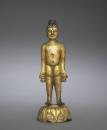侧边栏
这是本文档旧的修订版!
降生像(Child Form)
表现释迦牟尼经“兜率天降生”、“白象入胎”、“住胎说法”终于从摩耶夫人“右肋降生”。佛经称,佛祖降生后,即向东西南北各行七步,并以右手指天,左手指地,同时做大狮子吼:“天上地下,唯我独尊”。
外文描述
The <color #ed1c24>Dhyana mudra (meditation mudra, 禅定印)</color> is used in representations of the Sakyamuni Buddha and Amitabha Buddha. Sometimes the Dhyana mudra is used in certain representations of Bhaisajyaguru as the Medicine Buddha, with a medicine bowl placed on the hands. It originated in India most likely in the Gandhara and in China during the Wei period (禅定印最可能起源于印度的犍陀罗时期和中国的北魏时期). The Dhyana mudra is also known as Samadhi or Yoga mudra. It shows both hands resting in the lap. The back of the right hand is leaning on the palm of the left hand. Often the thumbs are touching each other, forming the mystic triangle. This is the meditation mudra, which symbolises wisdom. The Buddha used this gesture during his final meditation under the Bodhi tree when he attained enlightenment.
相关页面
造像特征
降生像造像特征,为童子形,上身赤裸,下着短裙,右手指天,左手指地。造像中凡为此种手印者,均为释迦牟尼降生像。
深度阅读: ……
参考文献:
……





